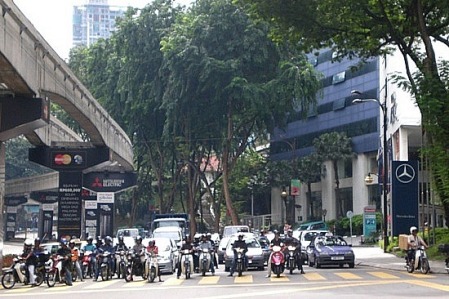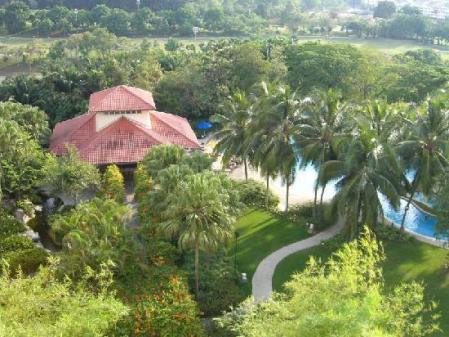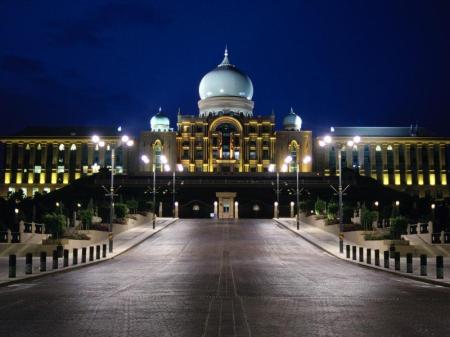Having overcome my doubts about Seoul, a month later I went to Kuala Lumpur. I made an overnight stop in KL in 2003 on my way to Japan on my first Brompton trip but I left the bike at the airport. Taking a walk from my hotel to the nearby twin towers I was struck by the brutality of the traffic, crossing the 6-lane main road meant a brisk jog to get across before the lights changed and I had no illusions that the Grand Prix would hold back on my account.
It’s not a surprise that Kuala Lumpur now hosts one of the Formula 1 races. Like Korea it’s a newly affluent country with a growing motor industry, unlike Koreans the normally relaxed and kindly Malaysians seem to turn to monsters behind the wheel. The city is laid out with a network of swirling expressways and there does not seem to be a way for a pedestrian or cyclist to get around without taking to motorised transport or the extensive metro system. This has created a great market for small motorcycles, large numbers of classic Hondas weaving in and out of the traffic, but you see very few cyclists although people say they always used bicycles in the old days before the city grew to swallow up the surrounding villages.
I thought very hard about whether to take my Brompton. It was only a short trip but I felt it was important to see what could be done. When my hosts told me which hotel I would stay in I thought, from the map, that it was in a relatively central area where it might be possible to get around some of the sights but then I found I was in a different branch of the same chain, away from the centre. It was in an out of town golf enclave and you could not ride more than half a mile without using a big main road, the whole area consisted of small housing or industrial areas only accessible from the main road, no local roads or paths visible on the map or satellite view.
So I packed my suitcase and went the “normal” way, by train and underground to Heathrow, having to get a lift to the station, struggling through the crowds at Paddington underground and then being chauffeured between hotel and university. Like having my legs cut off.
It was particularly unpleasant being stuck in a big hotel, infantilised by the impossibility of doing anything for myself, not a shop or cafe anywhere near, everybody being very helpful and not letting you lift a finger for yourself but mainly providing you with stuff you didn’t want. The month before in Seoul I had stayed in a budget hotel in the city and could walk out to a shop or cafe, or cycle away anywhere in the city, a place with a genuine street life.
The climate, in the tropical rainy season, was very warm and humid but Mr Pumpy is very emphatic that cycling in South East Asia can be delightful with the airflow to keep you cool. The scenery is beautiful, even in the outskirts of KL where outcrops of often ugly urbanisation intrude between the lush green hills. Mists swirl across the hillsides and I had breakfast to the sound of monkeys whooping in the tress nearby. All you need is a basic country road winding off into the trees but instead the whole territory has been quartered up by expressways, nothing so modernist as the newly modern.
It’s sad because this is basically a very civilised country. Malays are charming and pleased to see you, they spend a lot of time having snacks and being polite (nobody gives a speech or talk without ten minutes of formalities) and they wear wonderful colourful clothes in a huge variety of batik fabrics. At a formal event while I was there only one person wore a suit. The male Vice-Chancellor of the university and director of the local museum were gorgeously turned out and the women are like a garden of multi-coloured flowers.
Meanwhile my host took me to see the vast Putrajaya government area newly built outside the city. It’s an impressive achievement, like the iconic Petronas towers that were briefly the tallest buildings in Asia, but as an architect colleague remarked, having reviewed a barrage of ambitious student projects, “How many iconic buildings can one city absorb?” Meanwhile at street level, my host acknowledged that the 2km long straight main drag joining up all the government buildings was a furnace on hot days, due to a total lack of trees, although it was great for huge military parades. With a little shade and some human scale street level development it would be a perfect situation for government workers, or even politicians, to cycle about their business, instead everybody uses their air-conditioned car even if they only have to go a short distance.
So if I get the chance to go again I’ll see if I can locate myself in the centre and take my bike, if only to avoid taking the tube across London. There must be some opportunities for urban cycling in Malaysia.





22 November 2009 at 23:31
As a Malaysian who is now living in New Zealand I can relate. Over the last 20 years I’ve seen KL (and Malaysian in general) change massively in terms of its traffic and social landscape.
Generally Malaysians are more affluent today than 20 years ago. However with the modern conveniences, they are also more stressed. There are new career and social demands which were unheard of 20 years ago, many Malaysians have changed with money and social standing being more important today.
Whenever I go back to Malaysia, I prefer to spend time with food and street hawkers who still make an honest (and very good) and humble living. They are generally happier than most Malaysian. Perhaps they’re more content with life.
Whatever it may be, the slow hawker bicycle cart among the busy KL traffic is the reflection of Malaysian street culture and values today.
21 January 2010 at 16:40
I have been using my Brompton M3L and now P6R in Kuala Lumpur for just over a year. Quite often using the P6R between cities by Commuter Trains.
There are some possible side roads that one can use to avoid fast moving vehicles, and of course depend upon your destination, or one may also choose a combination of using the mono-rail / cycling to get around the City or the suburbs.
Unfortunately there is no dedicated cycle-path in the city, but one may find some pleasant cycling in beautiful rural (out of town) villages (kampung).
21 January 2010 at 17:02
Great, thanks for that Bil Choy. On my last visit I was in a hotel on the edge of KL and I could see that although I could use the bike in the local area it was quite a challenge to move between the different districts without going on to the big main roads for quite a distance. I think if I had been in the city centre I might have taken the bike. I might go again in a year or so and I’ll definitely have a second look, not having my Brompton is like having my legs cut off.
21 January 2010 at 17:59
Over a year ago while I was in Bristol, I tried the Bristol to Bath Railway Path. Being unfamiliar in Bristol, I made the mistake of asking non-cyclist the direction and I was often pointed exactly how a car or bus route will take toward the entrance to the Railway Path, and finally found myself wondering around in busy main roads.
When I finally asked a cyclist for direction, he gave me direction as a cyclist would use. What a big difference. I definitely will seek your advice on cycle routes in your place or places that you are familiar with as a cyclist. So on your next trip here, I will be glad to assist whenever possible.